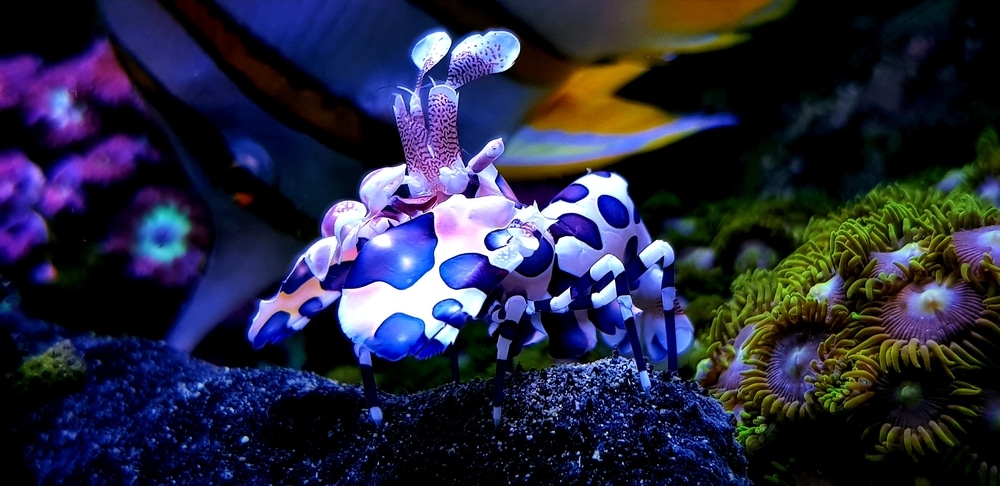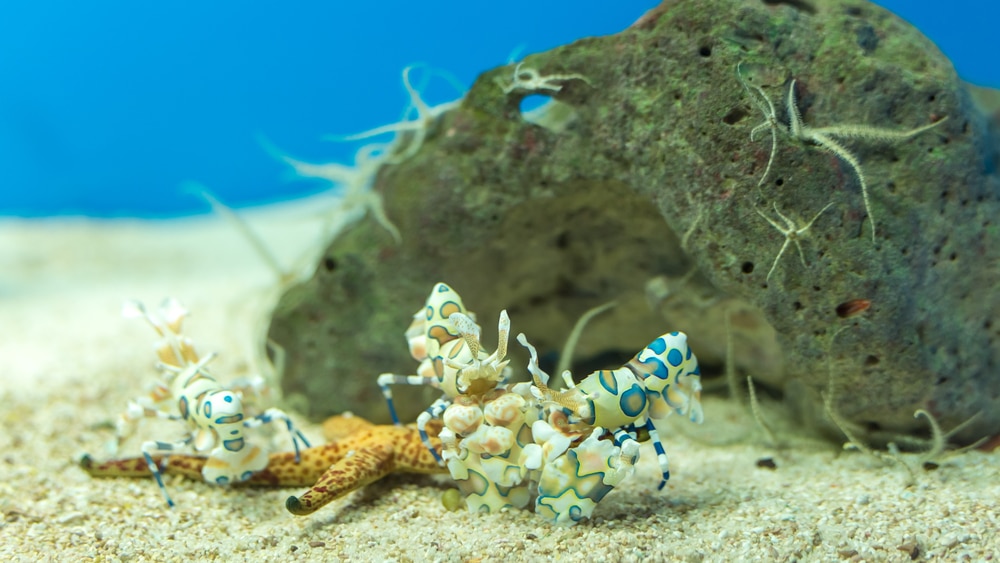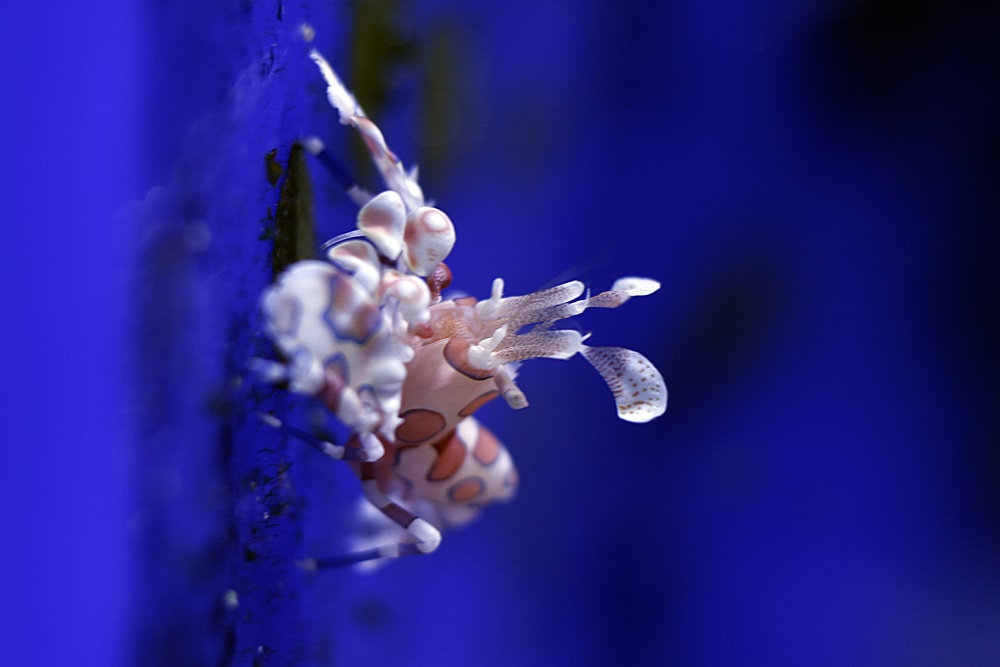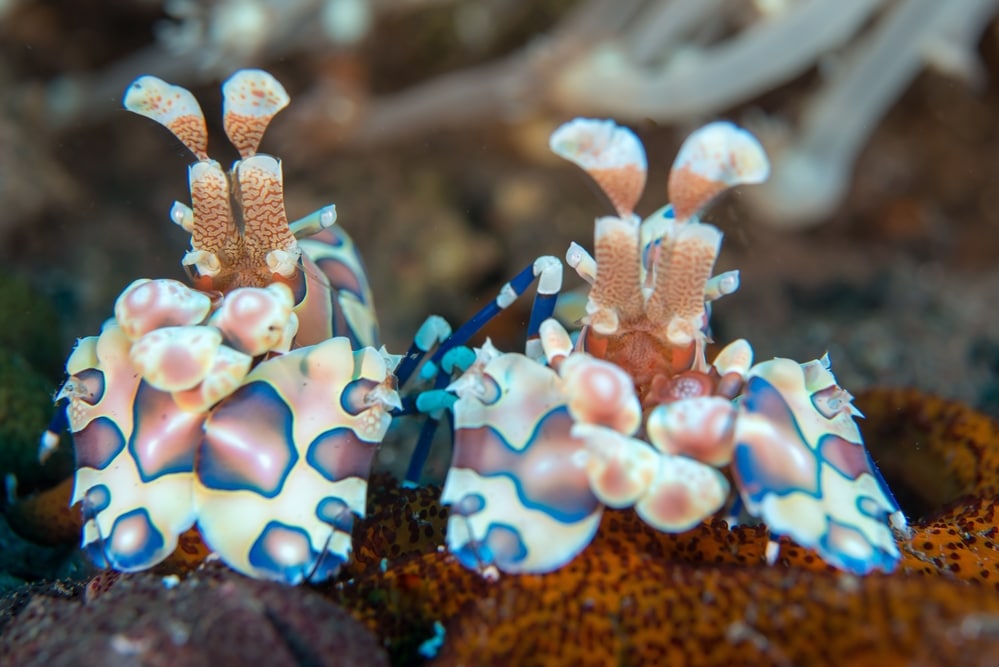How Often to Feed Harlequin Shrimp
BuildYourAquarium.com is supported by our readers. When you buy through links on our site, we may earn a commission. Learn more.
Looking upon a Harlequin Shrimp for the first time is like looking at a fantasy creation. They are so whimsical in appearance you would be forgiven for thinking it's simply not real.
Harlequin Shrimp carry a price tag to match their good looks and are challenging even for expert aquarists. But if you're interested in a shrimp that's as unique as it is beautiful then you should continue reading!
About Harlequin Shrimp
Harlequin, or Painted Shrimps, are very aptly named. Looking at them, the chaotic patterns seem like a bad choice. After all, surely a predator would have no trouble picking them out, right?

Like many other reef animals, Harlequin Shrimps are actually camouflaging themselves by being so bright! Take a look at corals, anemones, sponges, bryozoans, coralline algae, and other coral reef fixtures.
These all tend to be extremely bright and oddly shaped. This shrimp with its warped patterns and bright spots blends right into the reef as its outline and form are obscured.
There are actually two species in the genus Hymenocera. There is the common Harlequin Shrimp, Hymenocera picta, and the Blue Harlequin Shrimp (H. elegans).
The jury is actually still out on whether or not H. elegans is simply a subspecies with different color than H. picta but for now they are classified as separate shrimp.
The Blue Harlequin Shrimp has bold blue spots with yellow edges and is found mostly in the Indian Ocean and Western Pacific Ocean. Meanwhile the common Harlequin Shrimp has brownish orange to bright pink spots with blue edges and is found throughout the central and eastern Pacific.
Both types of Harlequin Shrimp are special for several reasons and well worth the challenges involved in keeping them. For one, they are one of the few shrimp that mate for life!
Males and females form pair bonds that last for years. Occasionally, if a young but fertile female is encountered the male will mate with her before returning to his chosen partner (typical).
They also have extremely specialized dietary habits. Harlequin Shrimps only eat starfish. And very occasionally sea urchins but usually only when they can't find any starfish to eat.

In ecology, these kinds of animals are called specialist predators. Specialists have dietary restrictions but tend to be very good at finding their chosen prey. And Harlequin Shrimp are no exception. Interested yet? Then let's talk about keeping these fascinating shrimp alive and well!
- Common Names: Harlequin Shrimp, Painted Shrimp, Blue Harlequin Shrimp
- Scientific Name: Hymenocera picta, H. elegans
- Origin: Tropical IndoPacific
- Length: 2 inches
- Aquarium Size: 10+ gallons
- Temperament: Peaceful; Territorial
- Ease of Care: Difficult

Harlequin Shrimp Care
In this section we'll learn about important care topics specific to Harlequin Shrimp such as aquarium size, feeding, water parameters, and more.
Aquarium Size and Aquascaping
Harlequin Shrimps are a fairly small species of shrimp that don't exceed 2 inches in length. Therefore they are suitable even for nano aquariums (tanks 20 gallons and under in size).
Just keep in mind that nano reef tanks are actually harder to maintain than larger aquariums because smaller bodies of water can shift much more rapidly than large ones.
And Harlequin Shrimp are highly sensitive to fluctuations in water parameters. I would only recommend keeping them in a tank smaller than 10 gallons if you're already an expert saltwater aquarist.
When aquascaping for Harlequin Shrimp, keep their secretive nature in mind. When given several caves to retreat to and even more importantly, a mate, your Harlequin Shrimp will be much more active in the open, even if you're nearby watching.
If there is too much bare ground and open water you may rarely see your Harlequin Shrimp as they feel continually exposed.
Water Conditions
Besides feeding, providing optimal water conditions is a major challenge in keeping Harlequin Shrimp. They are highly sensitive to sudden fluctuations in water parameters, which is causing their population numbers to drop due to climate change.
They prefer temperatures between 72-82℉, a pH of 8.0-8.4, and a specific gravity (salinity) of 1.023 – 1.025. Carbonate hardness can be between 8 to 12 degrees.
Like all invertebrates they are highly sensitive to accumulated nitrogenous wastes (ammonia, nitrite, and nitrate) but even more than most species. You should be aiming for 0ppm in all three categories.
Harlequin Shrimp therefore should only be added to an established marine aquarium that has stable parameters and a mature biological filtration system. You should also have a refugium, protein skimmer, or other way of further mitigating organic and nitrogenous waste accumulation.
These shrimp also don't do well with any sort of strong current and are weak swimmers and crawlers. Harlequin Shrimp can easily get sucked up into filter and powerhead intakes, which would be a disaster even if they weren't very, very expensive. So keep a sponge cover over the intakes even if your filter unit has a plastic guard in place.
These shrimp prefer scooting around and among coral rubble, which is where you'd typically find starfish, rather than climbing on exposed coral outcroppings.
Your filter outtake therefore needs to be directed in such a way to protect them from being too affected by it. Two methods of doing so are directing your filter so that the water flows horizontally across the surface or using a spray bar to dissipate the force of the outflow.
Are Harlequin Shrimp Reef Safe?
Harlequin Shrimps are some of the best shrimp for your coral reef aquarium. Most shrimp are scavengers and omnivores. This means they will opportunistically nibble on just about anything that won't fight back.
Since Harlequin Shrimp only eat starfish they won't bother feather duster worms, corals, anemones, sponges, and other sessile (non-moving) invertebrates. In fact, they are actively beneficial for reef tanks because they can help control invasive Asterina (Asterina sp.) starfish populations.
Asterina are the bane of many reef keepers. These tiny starfish rarely grow beyond 1 inch in diameter and have a tendency to explode in numbers because nothing wants to eat a hard skinned, noxious-tasting starfish.
Asterina have the ability to reproduce by fission, something few multicellular animals can do. Essentially they will shed a leg, a group of legs, or even split themselves in two. Instead of being dead, you now have two Asterina starfish that will go in to divide themselves further.
And if you try to control them by plucking them or worse, crushing them, then the fragments left behind can all grow into new starfish. Most Asterina are harmless detritivores, feeding on algae and other leftovers.
But a few species can cluster and feed on coral polyps. And since most invertebrate killing agents are broad spectrum this makes an Asterina infestation dangerous for established reef tanks.
This is where Harlequin Shrimp fit in! As dedicated starfish feeders they absolutely love being kept alongside Asterina. In fact, you may even add a few of the harmless types if you want to provide a never-ending source of food for your shrimp.
Harlequin Shrimps eat these tiny starfish in their entirety, leaving no bits behind to regenerate into new Asterina.
Tank Mates for Harlequin Shrimp
Harlequin Shrimp do well with any sort of fish or invertebrate that's already reef safe or small enough not to eat it. This includes nano reef fish like Basslets, Gobies, Firefish, and Cardinalfish.
Smaller Clownfish species like the True Percula Clownfish (Amphiprion percula) will also do well alongside fully grown Harlequin Shrimp. Small, peaceful Damselfish like the Yellowtail Blue Damselfish (Chrysiptera parasema) are also good matches for them.
But stay away from most other Clownfish and Damselfish species as they can grow large and aggressive enough to make a meal of these shrimp. Many marine fish specialise in eating invertebrates, including Puffer fish, Triggerfish, and Wrasses so avoid all of these fish.
Most small to medium sized shrimp and saltwater snails also work nicely as tank mates. Avoid crabs, however, as they are all opportunistic predators. A large enough crab, even a delicate-looking kind like most Arrow Crabs, may decide to overpower and eat.
However, small algae-eating crabs, such as the Green Emerald Crab (Mithrax Sculptus) and smaller Hermit Crabs are all excellent tank mates.
Good Tank Mates for Harlequin Shrimp:
- Basslets, Gobies, Firefish, Clownfish, Cardinalfish, and other small reef-safe fish
- Tangs, Lawnmower Blennies, and other vegetarian marine fish
- Scarlet Cleaner Shrimp, Blood Red Fire Shrimp, and other peaceful shrimp
- Snails, small Hermit Crabs, and other smaller invertebrates
- Corals, Sponges, Feather Duster Worms, Clams, and other sessile invertebrate
Poor Tank Mates for Harlequin Shrimp:
- Medium to Large fish
- Invertebrate-hunters (Triggerfish, Puffer Fish, Wrasses, etc)
- Crabs and Serpent Starfish
Feeding Harlequin Shrimp
While water quality is a big challenge, feeding Harlequin Shrimp can be an even greater one. These shrimp have one of the most specialized diets you can possibly think of. And if you don't provide it they will starve; they aren't a species you can wean onto chunks of seafood or other substitute items.
Fortunately, Harlequin Shrimp aren't picky when it comes to what type of starfish you give them. Just about any species will be eaten and at nearly any size. Stick to starfish that are medium sized. Most of the more common aquarium starfish species will work nicely, such as Chocolate Chip Starfish (Protoreaster nodosus) or any of the Linckia sp.
As mentioned earlier they will also hunt down and eat Asterina starfish, which tend to grow out of control in most aquariums. Also remember that all Starfish have the ability to regenerate to varying degrees. This makes a few large or many small starfish a fantastic long-term food source even if you don't have a reliable supply.
When given a good-sized starfish, you may find your Harlequin Shrimp pair work in tandem with each other. They will do their best to first dislodge it from the substrate and then flip it over. This makes it nearly impossible for the starfish to escape.
Flipping it over also exposes its delicate tube feet, which are the first thing the Harlequin Shrimp eats. Starfish use these to attach firmly to hard surfaces and without them its fate is sealed.
Then the Harlequin Shrimps either work their way up each arm to keep it alive as long as possible or start eating into the central disk, which quickly kills the starfish.
Lastly, remember that their diet is rather messy. Dead invertebrates will quickly pollute the water if the remains are left to rot. And Harlequin Shrimp are very sensitive to ammonia and other waste products. So be diligent with water changes and removing their leftovers once the starfish dies.
Sexing and Breeding Harlequin Shrimp

Keeping a pair of Harlequin Shrimps is highly recommended. They have complex social behaviors and work together as hunters to bring down larger starfish. However you need to sex them because they are very aggressive towards members of the same sex.
Reliably sexing Harlequin Shrimp is challenging unless you know exactly what to look out for. They look all but identical to our eyes unless you happen to look under their tails. In males there are none of the colorful spots that cover their bodies.
Female Harlequin Shrimp have spots under their tails. They are also typically larger than males but only by a little bit.
Alternatively, you can sometimes buy mated pairs of wild-caught Harlequin Shrimp. Or a pair bond might form spontaneously in a pet store holding tank. If there are several shrimp crammed together you may be able to identify a pair by watching their interactions with the other shrimp.
The pair will have likely claimed the best hiding place for themselves and work together to actively ward off intruding shrimp.
Breeding Harlequin Shrimp is as challenging as simply keeping them alive, unfortunately. Assuming you provide them with optimal water quality, a good mate, and a steady supply of food, you have an excellent chance of seeing eggs develop.
Like all shrimp the female will eventually "berry" and carry her eggs underneath her abdomen. Harlequin Shrimp lay anywhere from 1000-5000 eggs at a time, giving you an idea of how tiny the newly hatched young are.
The female will carry the eggs for 2-3 weeks, gently fanning them to keep them oxygenated. Once the eggs are close to hatching (within 2-3 days) they turn translucent and the female typically stops eating.
At this stage your best bet is to move both her and her mate (to reduce stress) to a separate aquarium to release her fry. Harlequin Shrimp have a planktonic phase that lasts 5-6 weeks before settling down and becoming tiny crawling shrimplets. The planktonic, free-swimming fry are so tiny that any sort of filtration will suck them right up.
Once the young shrimp hatch the parents can be moved back into the main tank. Harlequin Shrimp fry feed on planktonic organisms. Green water algae, rotifers, and the like provide sustenance until they grow large enough to feed on brine shrimp nauplii and other larger items.
You can easily culture brine shrimp nauplii to have on hand for this phase. Once the shrimp grow large enough to be kept in the main tank you can resell them back to the pet store for a hefty profit.
truesdalegeon1937.blogspot.com
Source: https://www.buildyouraquarium.com/harlequin-shrimp/

0 Response to "How Often to Feed Harlequin Shrimp"
Post a Comment